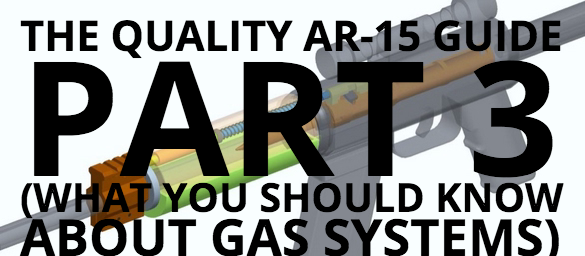Thus far in this series, we’ve covered the heart and soul of the AR-15 — that is the Bolt Carrier Group and the Barrel — and what to look for to make sure you’re getting quality parts.
But there’s one more part of the AR-15 that is important enough to devote an entire article to …
That’s the Gas System.
Why is the AR-15 Gas System important?
The gas system in an AR-15 is what runs the gun. Without the gas system, you’d have essentially a bolt-action rifle in your hands.
The original design of the AR-15 platform was for a direct impingement (DI) gas system, which we will focus on here.
Why not a piston gas system? The list of reasons is beyond the scope of this article but for now I’ll just say the DI system is just as reliable, less money, lighter weight, lower recoil, and has greater part interchangeabiliy and it’s easier to find replacement parts because there’s actually a standard.
With that said, here’s how the DI system works (in a nutshell) …
When you fire a shot from your AR-15, gas pressure builds up inside the cartridge case expanding the case and holding it in the chamber while the internal pressure from the cartridge launches the bullet down the barrel.
As the bullet went out the barrel, the gas that propelled it out escapes through the hole in the top of your barrel called the gas port. That gas continued through the gas port, the gas block, down the gas tube and into the gas key on the top of your Bolt Carrier Group (BCG).
This causes the BCG to start unlocking from the chamber and start moving backwards, pulling the now empty cartridge case from the chamber and ejecting it as it moves back past the ejection port. After the BCG slows and cycles forward, it strips the next round off the top of the magazine and chambers it, readying the cartridge for your next shot.
As you can see there are a lot of parts working together. The full-auto BCG we’ve chosen allows the BCG to do its job, so let’s talk about the gas system that powers this thing …
The 3 most common gas system lengths and which is the best …
There are essentially three gas systems to choose from with the modern AR-15. The rifle length, mid-length, and carbine length.
Here’s the key difference between these systems: the shorter the gas system the more system pressure is used to cycle the rifle. And the shorter the “cycle time”.
Theoretically, the longer the gas system the more reliable the rifle because of the A.) longer cycle time giving the BCG more time to do its thing (even if dirty) and B.) less wear & tear on the parts …
1.) Rifle Length. This is normally found on the 18-20″ barrelled rifles and is the original design by Eugene Stoner. This system has the best performance and highest reliability of all lengths, but it requires the longer 18-20″ barrel. Commonly used by the military with M16 rifles.
2.) Carbine Length. This is the modern design used on military M4 carbine rifles. It’s the shortest you can go and still be reliable because the M4 has a 14.5″ barrel. Of note, even the shorter 10.3″ Short Barrel Rifle (SBR) platform used by some special teams in the military use the carbine-length gas system.
3.) Mid-Length. This is the “in between” size of rifle and carbine. Because there are federal laws making anything shorter than a 16″ barrel a short barrel rifle (yes, even 14.5″ … stupid huh?) — the 16″ barrel is arguably the most popular civilian rifle for a carbine length choice.
In short, for a civilian legal “carbine” with a 16″ barrel, the mid-length gas system delivers the Jack-of-all-trades, best of both worlds, compromise.
It (should) have a higher reliability and lower parts wear than the carbine length system … and … much of the reliability and lower-recoil of the rifle-length system without the downsides of the longer barrel.
Why recoil reduction matters…
The fact is the 5.56/.223 is not a hard-kicking rifle, so you might not consider recoil reduction to be important. But these same parts all work together to reduce recoil and it doesn’t matter how “tough” you are, a low-recoil rifle is more desirable.
For one, it’s more accurate because it makes the gun a “flat shooter”. Plus, the less recoil, the faster you can engage multiple targets or get your sites back on the same target for the next, more accurate shot.
This is especially obvious when you are shooting using a magnified scope and each shot moves your crosshairs off target and you have to “find” your target again each time.
And let’s not forget that your children or maybe a female shooter might have to use your rifle to defend your home one day. You want a rifle that shoots flat, accurate, and with little-recoil so they can be as effective as possible with the weapon.
In conclusion…
For all these reasons and more, the 16″ barrel with a mid-length gas system is quickly becoming the new “standard” for a quality AR-15 rifle.





![How Many Shots Will It Take? [Video]](/wp-content/uploads/2025/06/Depositphotos_2724272_S-218x150.jpg)




![What Level Holster Should You Be Using? [Video]](/wp-content/uploads/2024/04/Depositphotos_44548439_S-218x150.jpg)





















![Optic Ready vs Milled slides? [Video]](/wp-content/uploads/2024/02/image-3-100x70.png)
![[Checklist] What Gear You Need To Take Pistol, Rifle & Shotgun Training Courses [Video]](/wp-content/uploads/2023/07/Depositphotos_275087632_L-100x70.jpg)
![What is in Carter’s 2023 EDC? [Video]](/wp-content/uploads/2023/07/Depositphotos_146856137_L-100x70.jpg)



Couldn’t disagree with you more about a piston sys. I might have agreed back when piston systems first came out but nowa days I wouldn’t use anything but a piston. If nothing else the bonus of having a cleaner receiver after shooting. The added weight added to the front end adds stability in either supported or unsupported firing. The only down side is finding a hand guard compatible with it. Samson Mnfg seems to be one of the few making them. I have a Colt le 6240 with a Odin Works SOCOM profile barrel with a mid length, a Sig 516, and a Stag M8. All are 100% reliable and Id bet my life on any of them
Im not knocking a DI Rifle in any way, I have a cpl of those too, just saying they are a perfectly good option.
I love my LWRC IC. SPR for the simple reason that the BCG is nearly spotless after firing 500-600 rds through it. The added weight is negligable and as was stated above adds to the stability of the weapon. More manufactures are adding this platform to there line since this will be the future.
i understood from yourrecomendation that mid lenth AR-15 with 16 “barrel is the best.If is so,how much it may cost and where i can get itin my state(md).i always like to have lisence for caring gun.
Caleb,
Many thanks for your analysis of the myriad of designs and options for ARs. I originally looked for one most like the one issued to me in 1973. Made “expert” with it at Ft. Ord, and thought it great to shoot. Now, its like comparing modern vehicles with a Model T. Up until now, been overwhelmed trying to select which would be best for me. Even books and magazines were not as comprehensive on the basics as your series, yet they went into infinite detail on minute differences in sling swivel options.
I just built a ar-15 platform… I didnt not go the way of direct impingment because of how filthy the upper reciever and gas tube get plus the gas tube explodes or gets gummed up with powder residue.. ive served in the military and i hated our issue m-16 because of the d.i system…
As i said i built a platform and i used a Adams arms piston kit .. yehaw wow is my upper somuch cleaner then before plus it expelles all gases forward of front site plus it keeps ur barrel cooler and your upper cold .. so. Much so u can pull the b.c.g out after 500 rounds with your hands and not get burnt or charred like on a d.i. system ….
Oh yeah it even kicks less then the d.i. systeem also.. lol.
Experiance with new matierals and out of box thinking works on everything even a flawed m-16 …
Ive have shown my build to multiple s.f. men. And they all loved shooting my gun because of easy of cleanning and ease of use for the user …
JPH
This has come a long way sense the “Mattel Toy” days ! I have 2 ARs one is a Carbine another I’m building I plan on using a heavy 24″ bull barrel with a fixed skeleton stock, some sort of scope,so I can reach out & touch someone. Next maybe an AR pistol, & an AR-10 also with a bull barrel & Fixed Stock
Caleb ,thanks for info. articals ,good read.
quiestion – confused -the diference between .223 and .556 ,is it just chamaber preshr – or is thair a chamber seat fit diference ? OR both ?
Please set it strait . And what is .223 Wilde ?
thank s – semper-fi
Confused , .223 an .556 is it just the chamber preasure or is their a chamber fit diference in the two at seat ? And what is with whats refered to as .223 wild barells ?
Please set strait Thanks -Semper-Fi
Comments are closed.